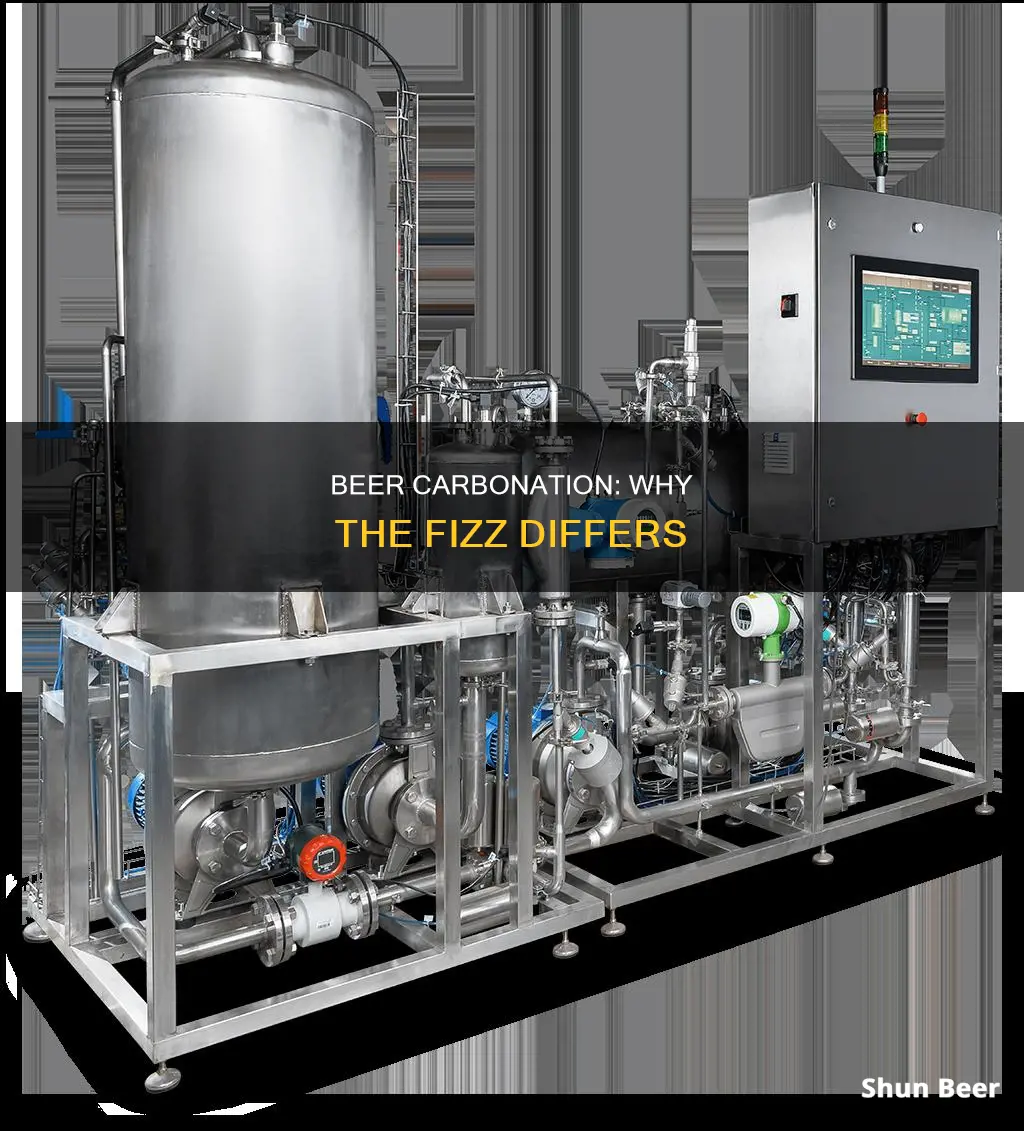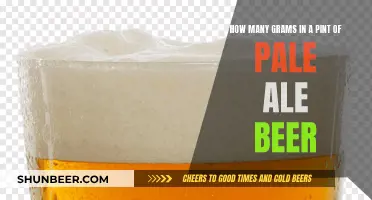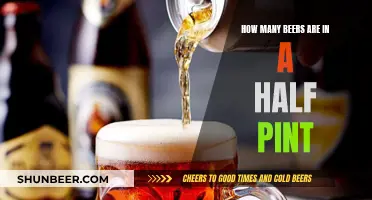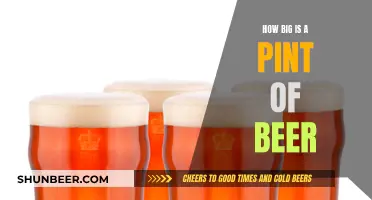
Beer carbonation is a defining texture of any beer style. Carbonation gives beer its distinct refreshing aspect and contributes to its mouthfeel. The carbonation level of a beer can vary depending on the type of beer and the brewing method. Carbonation occurs naturally in beer as yeast produces carbon dioxide along with alcohol when they eat sugar. The amount of carbonation in a beer can be controlled by adjusting the amount of sugar added during the brewing process. Different methods of carbonation, such as natural and forced carbonation, result in different levels of carbonation in the final product.
What You'll Learn

Natural vs forced carbonation
The final step in brewing beer is to carbonate it. Carbonation gives beer a light and refreshing feel in the mouth when consumed and also enhances flavours and aromas. There are two ways to carbonate beer: natural carbonation and forced carbonation.
Natural Carbonation
To naturally carbonate beer, a small amount of sugar (called priming sugar) is added to the beer after fermentation has completed. The beer is then put into bottles, growlers, kegs, etc. and sealed. Residual yeast will then ferment this sugar and produce alcohol and CO2. Because the vessel in which the beer is being held is sealed, this CO2 dissolves into the liquid, carbonating the beer.
Advantages
- Requires less equipment than forced carbonation
- It's traditional and all-natural
- Results in a thicker head, smaller bubbles, and more lacing
Disadvantages
- Takes longer to carbonate the beer (2-4 weeks)
- If too much sugar is added, the beer can be over-carbonated or bottles can explode
- More yeast will settle at the bottom of the bottles, which doesn't look pretty
Forced Carbonation
To force carbonate beer, it is transferred to a keg where it is chilled. CO2 is then pumped into the keg and kept at pressure. Over the course of a few days, this CO2 will dissolve into the beer, carbonating it.
Advantages
- Takes much less time to carbonate beer (3-7 days)
- Results in a cleaner-looking beer
- Takes the guesswork out of adding priming sugar
- Doesn't result in added yeast flavours in the final product
Disadvantages
- Requires expensive equipment
- Can result in a head that is less billowy and has worse lacing
- Deviates from the all-natural brewing process
EBC Beer Shipping: State-by-State Availability and Restrictions
You may want to see also

The role of yeast in carbonation
Yeast is a type of fungus that is commonly used in the process of fermentation in brewing. It plays a crucial role in the carbonation of beer and other fermented beverages. During the brewing process, yeast is added to a mixture of malted grains and water. The yeast then consumes the sugars present, converting them into carbon dioxide and a small amount of alcohol. This carbon dioxide gets trapped in the liquid, creating the bubbles and fizz characteristic of beer.
Natural carbonation occurs when yeast is combined with a sugary liquid. In beer-making, after the initial fermentation, home brewers add priming sugar before bottling. The yeast consumes this sugar, converting it into carbon dioxide. The duration and amount of sugar added are crucial to achieving the desired level of carbonation. Over-carbonation can lead to exploding bottles, while too much sugar being consumed by the yeast can result in a bland-tasting, overly fizzy beer.
Champagne yeast is recommended for the best bubbles in natural carbonation. Baker's yeast or brewer's yeast can also be used but will result in a less bubbly beverage. It is important to note that the type of yeast used can impact the flavour of the final product. For example, using bread yeast in soft drinks will impart an undesirable bread-like flavour.
Yeast is an essential, inexpensive ingredient for achieving natural carbonation in beverages. It allows for the creation of carbonated drinks without the need for forced carbonation methods that require additional equipment, such as a CO2 tank. However, the use of yeast can result in yeast residue in the final product, and the process may take longer compared to forced carbonation.
Explore the Difference Between Ales and Lagers in Beer
You may want to see also

How to store beer correctly
Beer is best stored in a cool, dark place, like a basement or a closet. The optimal temperature range for packaged beer is between 45 and 55 degrees Fahrenheit. Beer should be stored upright, as this minimises the amount of the beer’s surface area that will touch the air trapped in the bottle.
If you don't have space in a cool, dark place, the refrigerator is the next best option. Beer will remain at its best quality for up to eight months in the fridge. If you don't have fridge space, beer can be stored at room temperature, but it will only stay at the best quality for up to six months.
If you're storing beer in a cellar, keep it at around 10 degrees below the beer's fermentation temperature. Make sure the cellar is dark, and don't disturb the beer once it's stored.
Kegs should be stored in a cool, dry space, away from other foods. Avoid moving kegs around too much, as this can increase the amount of foam that spurts out when you tap the keg.
Exploring Diverse Beer Markets: A Global Perspective
You may want to see also

How to carbonate beer in a keg
The carbonation level of beer is usually expressed in terms of "volumes" or grams of carbon dioxide per litre of beer. The colder the beer, the more carbon dioxide can be held in the solution. Most carbonation in kegs is done using pressurised CO2 from a gas cylinder, a process called force carbonation.
- Ensure you have the necessary equipment: tubing and keg disconnects for gas and liquid, a CO2 gas cylinder, a CO2 beer regulator for adjusting carbonation levels, and a force carbonation chart.
- Transfer your beer to a keg.
- Purge the keg of oxygen to prevent oxidisation and stale beer. Connect your gas line to your gas post and set your regulator to 10 PSI. Repeat this process four times.
- Seal the keg by hitting it with an initial 30 PSI to ensure no CO2 can leak out.
- Set your refrigerator temperature and your desired carbonation rate. Set your CO2 regulator to that pressure and wait 5-10 days for the beer to carbonate.
- To speed up the process, you can put 30-40 PSI of CO2 into your chilled keg and shake or rock the keg to diffuse the gas faster. Depending on how cold your beer is and how much you agitate it, you can have your beer carbonated in 12 hours to 3 days.
- Once carbonated, dial your CO2 regulator down to serving pressure (10-12 PSI) and vent excess CO2 from the keg.
- Wait an hour or two for the beer to settle before serving.
An alternative method is to use priming sugar to carbonate your beer. This is a natural process that involves adding a priming solution (water and sugar) to the flat beer before bottling to initiate a "re-fermentation". The CO2 produced is absorbed into the beer, creating carbonation. The amount of carbonation can be controlled by adjusting the amount of priming sugar. After priming and filling, the beer should be stored at 70-75°F for 2-3 weeks or until fully carbonated.
Pilsner vs Lager Beer: What's the Difference?
You may want to see also

The impact of temperature on carbonation
Carbonation refers to carbon dioxide dissolved in a liquid. The rate at which carbon dioxide dissolves depends on temperature. When the temperature is raised, the rate of dissolution in liquid is decreased, and vice versa when the temperature is lowered.
Beverage manufacturers use this principle to their advantage. For example, the forced carbonation method is a technique that pumps pressurised CO2 gas into a headspace or liquid inside a pressurised vessel. The carbonation process is complete once the equilibrium with partial pressure is reached between the product and the headspace. The forced carbonation method is used most commonly in the sparkling beverage industry because it can easily and quickly carbonate large volumes of beverage within hours. The level of carbonation depends mainly on the pressure of CO2 and temperature, because water will have a greater carbon dioxide solubility at lower temperatures (for a given pressure).
The process of carbonation is based on the principle that high pressure and low temperature maximise gas absorption. The process begins once carbon dioxide is brought into contact with the liquid. The gas dissolves into the liquid until the pressure becomes equal to the pressure that pushes down the liquid to stop the process. As a result, the temperature has to be lowered to about 36 to 41 degrees Fahrenheit to continue the process.
When a carbonated drink is opened or poured into an open glass, it bubbles or fizzes to indicate that the carbon dioxide is slowly evaporating or dissipating. Once pressure is reduced, carbon dioxide is released from the solution in the form of small bubbles, making the drink froth or fizz regardless of temperature. When the carbonated drink is colder, the dissolved carbon dioxide is more soluble and fizzes more when opened.
Carbonated drinks tend to lose their fizz at higher temperatures because the loss of carbon dioxide in liquids is increased as temperature is raised. This can be explained by the fact that when carbonated liquids are exposed to high temperatures, the solubility of gases in them is decreased. Consequently, gas that has not dissolved can easily be lost.
Explore the Difference Between Ales and Lagers
You may want to see also
Frequently asked questions
Carbonation is the process of adding carbon dioxide gas to a liquid. The gas is held in the liquid by pressure, which is why a bottle of beer is sealed. When the pressure is released by opening the bottle, the carbon dioxide rises and escapes in the form of bubbles.
There are two main methods of carbonating beer: natural carbonation and forced carbonation. Natural carbonation occurs during the fermentation process, when yeast produces carbon dioxide as it digests sugar. Forced carbonation involves pumping carbon dioxide into a sealed container with the beer.
The carbonation level of beer can vary depending on the style of beer and the brewing method. For example, most ales have around 4.8g/L of carbon dioxide, while lagers or wheat beers typically have more. The amount of carbonation can also be adjusted by controlling the amount of sugar added during the brewing process.







